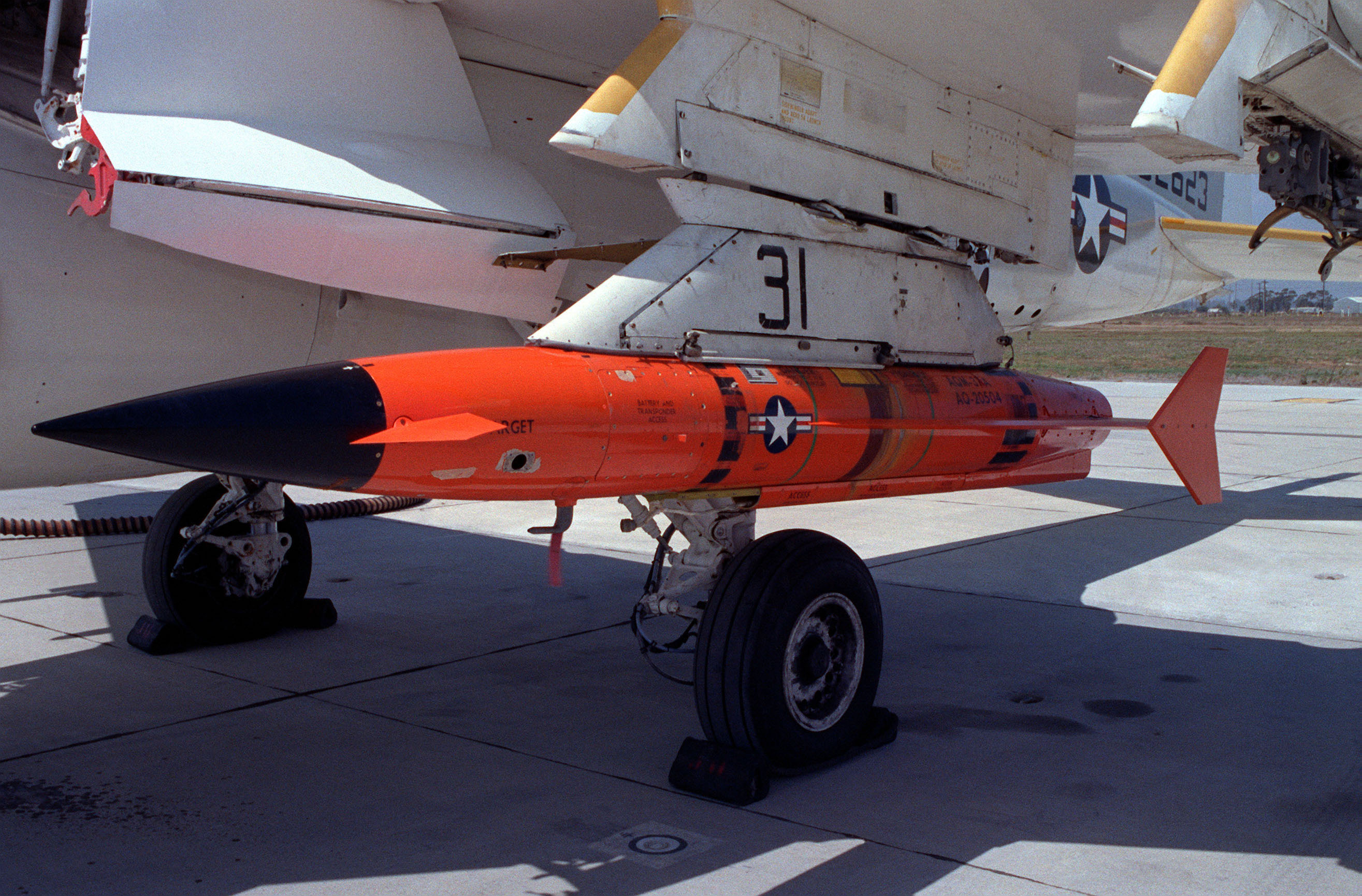- AQM-37 Jayhawk
infobox Aircraft
name = AQM-37 Jayhawk
type =Unmanned aerial vehicle drone
manufacturer =Beechcraft 
caption = An AQM-37A target under the wing of an A-6E Intruder.
designer =
first flight = May1961
introduction =
retired =
status =
primary user =US Navy
more users = Britain
produced =
number built = 5,000+
program cost=
unit cost =
developed from =
variants with their own articles =The AQM-37 Jayhawk (originally designated the Beech KD2B) is an air launched supersonic target drone manufactured by
Beechcraft (nowRaytheon ) capable of simulating inboundICBM warhead packages for fleet shoot-down exercises.Development
AQM-37
In the 1959, the
US Navy andUS Air Force issued a joint request for a new high-speed expendable target. Beechcraft won the competition, and the result was a small delta-winged drone with wingtip fins and a liquid rocket motor, originally designated XKD2B-1 but now known as the AQM-37. The type first flew in May1961 , entered service with the US Navy in1963 , and remains in service.The original version was the AQM-37A or Beech Model 1019. The AQM-37A was followed by a confusing list of subvariants, some of which were new production, others which were modifications of existing AQM-37s. These variants were intended to simulate different classes of threats, such as sea-skimming antiship missiles or high-altitude naval attack missiles, or provide better performance. One high-performance variant with improved thermal protection attained a speed of Mach 4.7 and an altitude of over 112,000 feet (34 kilometers) on a ballistic trajectory. The final US Navy variant was designated AQM-37C.
After an evaluation of the AQM-37A in the late 1960s, the US Army bought a small initial batch of Model 1100/1101 AQM-37As that, unlike other variants, were recoverable, using a parachute system. Some of this batch were intended for low-altitude operation and fitted with a radar altimeter, and others were intended for high-altitude operation and had a barometric altimeter. The Army later ordered over 400 improved non-recoverable Model 1102 variants of the AQM-37A.
The USAF evaluated the AQM-37 in the early 1970s but was slow to adopt it. Records of USAF procurement of the type are sketchy, but it does seem to be currently part of the Air Force target inventory. Small quantities of AQM-37s were also sold to
Italy ,Israel , andFrance , while Britain bought several hundred of the type. The Meteor company of Italy built a number of AQM-37s under license.All variants are air-launched, with the US Navy traditionally using the
F-4 Phantom for the job and the British using the Canberra.More than 5,000 AQM-37 targets of all variants have been delivered since the early 1960s. The AQM-37C/D is still in limited production for the
U.S. Navy .The AQM-37's engine is built by Rocketdyne, though in some sources it is credited to
Harley Davidson , the motorcycle manufacturer, which appears to be due to a sequence of company buyouts. The engine uses "storable" liquid propellants, in contrast tocryogenic propellants likeliquid oxygen andliquid hydrogen that have to be loaded up just before launch lest they evaporate away. The problem is that the storable propellants in common use are corrosive, highly toxic, and "hypergolic", meaning that the propellants spontaneously ignite when mixed together. This tends to make them troublesome to deal with.AQM-81A Firebolt
As a result, in the late 1960s the Air Force investigated an alternate propulsion scheme for the AQM-37 under project "Sandpiper". The program involved fitting a few AQM-37As with "hybrid" engines that used solid fuel with storable nitric acid oxidizer. The tests were judged promising, and so the Air Force went on to establish a "High Altitude Supersonic Target (HAST)" program in the 1970s. HAST suffered various difficulties, and it wasn't until 1979 that a contract was awarded to Teledyne Ryan for the Model 305 / AQM-81A Firebolt.
The first Firebolt flew in 1983. The new target looked very much like the AQM-37, but had the hybrid rocket engine. The flight test program was completed, but then the HAST effort stalled completely, and the AQM-81A never went into production.
pecifications
aerospecs
ref=
met or eng?=engcrew=0
capacity=
length m=4.27
length ft=14
length in=0
span m=1.00
span ft=3
span in=4
height m=0.66
height ft=2
height in=2
wing area sqm=
wing area sqft=
empty weight kg=
empty weight lb=
gross weight kg=280
gross weight lb=620eng1 number=1
eng1 type=Rocketdyne LR64-NA-4 liquid-fueled rocket
eng1 kn=3.78
eng1 lbf=850
eng1 kn-ab=
eng1 lbf-ab=max speed kmh=
max speed mph=
max speed mach=4.0
cruise speed kmh=
cruise speed mph=
range km=180
range miles=113
endurance h=
endurance min=
ceiling m=30,000
ceiling ft=100,000
climb rate ms=
climb rate ftmin=armament1=
armament2=
armament3=
armament4=
armament5=
armament6=References
* [http://www.designation-systems.net/dusrm/m-37.html Directory of U.S. Rockets and Missiles - AQM-37]
* [http://www.designation-systems.net/dusrm/m-81.html Directory of U.S. Rockets and Missiles - AQM-81]
*This article contains material that originally came from the web article [http://www.vectorsite.net/twuav.html "Unmanned Aerial Vehicles"] by Greg Goebel, which exists in the Public Domain.
Wikimedia Foundation. 2010.
